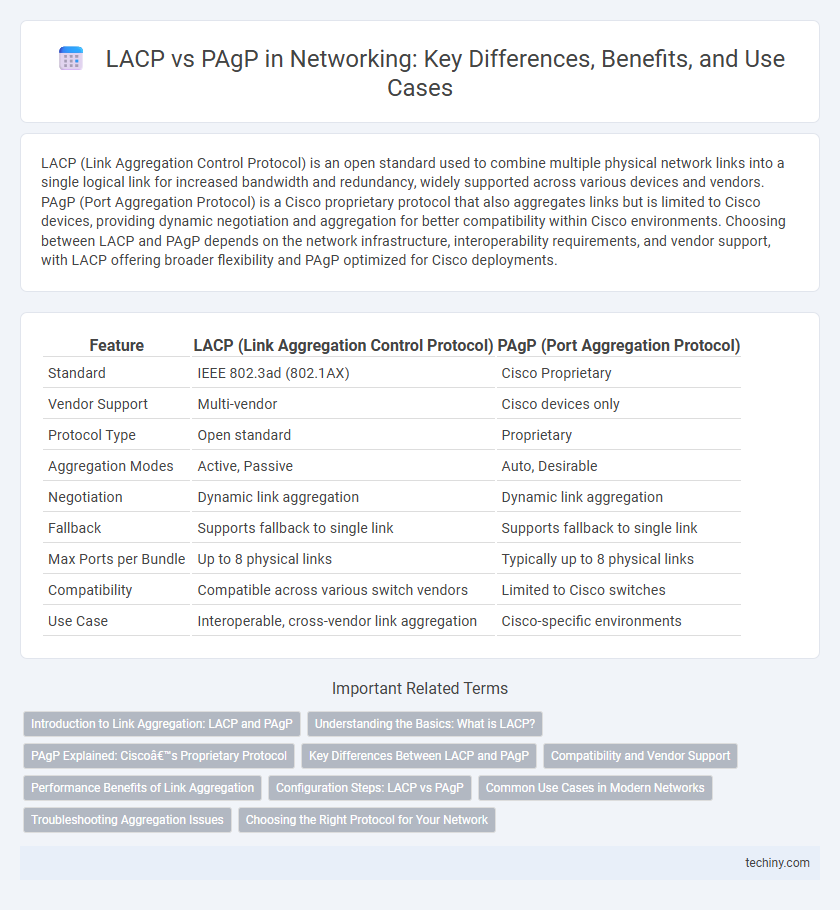LACP (Link Aggregation Control Protocol) is an open standard used to combine multiple physical network links into a single logical link for increased bandwidth and redundancy, widely supported across various devices and vendors. PAgP (Port Aggregation Protocol) is a Cisco proprietary protocol that also aggregates links but is limited to Cisco devices, providing dynamic negotiation and aggregation for better compatibility within Cisco environments. Choosing between LACP and PAgP depends on the network infrastructure, interoperability requirements, and vendor support, with LACP offering broader flexibility and PAgP optimized for Cisco deployments.
Table of Comparison
| Feature | LACP (Link Aggregation Control Protocol) | PAgP (Port Aggregation Protocol) |
|---|---|---|
| Standard | IEEE 802.3ad (802.1AX) | Cisco Proprietary |
| Vendor Support | Multi-vendor | Cisco devices only |
| Protocol Type | Open standard | Proprietary |
| Aggregation Modes | Active, Passive | Auto, Desirable |
| Negotiation | Dynamic link aggregation | Dynamic link aggregation |
| Fallback | Supports fallback to single link | Supports fallback to single link |
| Max Ports per Bundle | Up to 8 physical links | Typically up to 8 physical links |
| Compatibility | Compatible across various switch vendors | Limited to Cisco switches |
| Use Case | Interoperable, cross-vendor link aggregation | Cisco-specific environments |
Introduction to Link Aggregation: LACP and PAgP
Link Aggregation Control Protocol (LACP) and Port Aggregation Protocol (PAgP) are two key protocols used to combine multiple physical network links into a single logical link to increase bandwidth and provide redundancy. LACP is an IEEE 802.3ad standard widely supported across multi-vendor environments, while PAgP is a Cisco proprietary protocol designed specifically for Cisco devices. Both protocols dynamically manage link aggregation groups (LAGs) to optimize network performance and ensure link stability through negotiation and automatic configuration.
Understanding the Basics: What is LACP?
Link Aggregation Control Protocol (LACP) is a standardized networking protocol defined by IEEE 802.3ad that enables the bundling of multiple physical Ethernet links into a single logical link to increase bandwidth and provide redundancy. LACP dynamically detects and manages the aggregated links, ensuring optimal load balancing and fault tolerance between switches. Unlike Cisco's proprietary Protocol Aggregation (PAgP), LACP is vendor-neutral, making it widely compatible across diverse networking equipment.
PAgP Explained: Cisco’s Proprietary Protocol
PAgP (Port Aggregation Protocol) is Cisco's proprietary protocol designed to automate the creation of EtherChannel links by negotiating aggregation parameters between Cisco devices. It ensures load balancing and redundancy by dynamically managing link bundling, improving bandwidth and providing fault tolerance. Unlike LACP, which is an open standard, PAgP operates only between Cisco devices, offering optimized compatibility within Cisco networking environments.
Key Differences Between LACP and PAgP
LACP (Link Aggregation Control Protocol) is an open standard defined by IEEE 802.3ad, enabling interoperability between multi-vendor devices, while PAgP (Port Aggregation Protocol) is a Cisco proprietary protocol limited to Cisco equipment. LACP uses active and passive modes to negotiate link aggregation, supporting dynamic link failover and load balancing, whereas PAgP operates with desirable and auto modes focusing on Cisco environments with fewer interoperability options. LACP's broader industry adoption ensures greater flexibility and compatibility across diverse network infrastructures compared to PAgP's vendor-specific implementation.
Compatibility and Vendor Support
LACP (Link Aggregation Control Protocol) is an open standard defined by IEEE 802.3ad, ensuring broad compatibility across multi-vendor network equipment. PAgP (Port Aggregation Protocol) is a Cisco proprietary protocol, limiting its use primarily to Cisco devices and reducing interoperability in mixed-vendor environments. The choice between LACP and PAgP depends heavily on existing network infrastructure and vendor support requirements.
Performance Benefits of Link Aggregation
Link Aggregation Control Protocol (LACP) and Port Aggregation Protocol (PAgP) both enhance network performance by combining multiple physical links into a single logical link, increasing bandwidth and providing redundancy. LACP, standardized by IEEE 802.3ad, offers better interoperability across multi-vendor devices and dynamic link management, which optimizes traffic distribution and minimizes congestion. PAgP, proprietary to Cisco, simplifies configuration within Cisco environments but may limit flexibility and scalability compared to LACP in heterogeneous networks.
Configuration Steps: LACP vs PAgP
LACP configuration requires enabling the protocol on each switch port with commands like "channel-group" followed by the desired group number and setting the mode to active or passive. PAgP setup involves configuring ports with "channel-group" and specifying modes such as desirable or auto for automatic negotiation of EtherChannel. LACP supports multi-vendor environments with IEEE 802.3ad standards, while PAgP is Cisco proprietary, affecting configuration compatibility across different network devices.
Common Use Cases in Modern Networks
LACP (Link Aggregation Control Protocol) is widely used in modern networks for its vendor-neutral support, making it ideal for multi-vendor environments and data centers requiring high availability and load balancing. PAgP (Port Aggregation Protocol) is typically deployed in Cisco-exclusive networks to optimize bandwidth and provide automatic configuration between Cisco switches. Enterprises implementing multi-vendor infrastructure prefer LACP for its interoperability, while Cisco-only environments often leverage PAgP for seamless integration and simplified management.
Troubleshooting Aggregation Issues
Troubleshooting aggregation issues in LACP (Link Aggregation Control Protocol) often involves verifying that the system priorities and port keys match on both ends to ensure successful link bundling. In PAgP (Port Aggregation Protocol), troubleshooting requires checking the PAgP mode compatibility (desirable or auto) and ensuring consistent switch port configurations to prevent aggregation failures. Examining logs and status outputs using commands such as "show etherchannel summary" can help identify misconfigurations or negotiation mismatches affecting link aggregation stability.
Choosing the Right Protocol for Your Network
Choosing the right protocol for your network depends on device compatibility and vendor support, with LACP (Link Aggregation Control Protocol) offering an open-standard solution widely supported across multiple manufacturers. PAgP (Port Aggregation Protocol) is a Cisco-proprietary protocol optimized for Cisco environments, providing seamless integration and enhanced feature support within Cisco switches. Evaluating network infrastructure and interoperability needs ensures optimal link aggregation performance and reliability.
LACP vs PAgP Infographic

 techiny.com
techiny.com